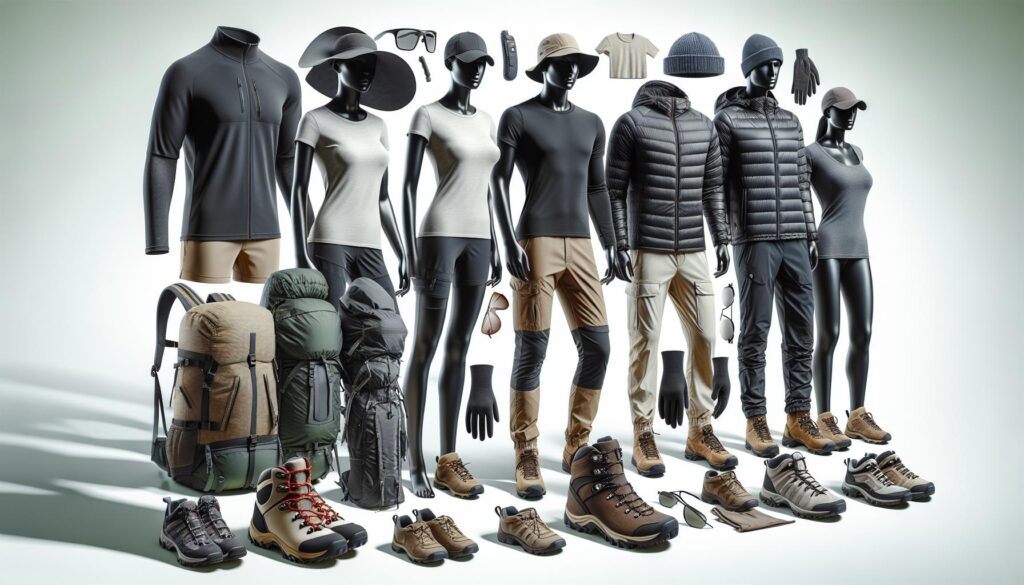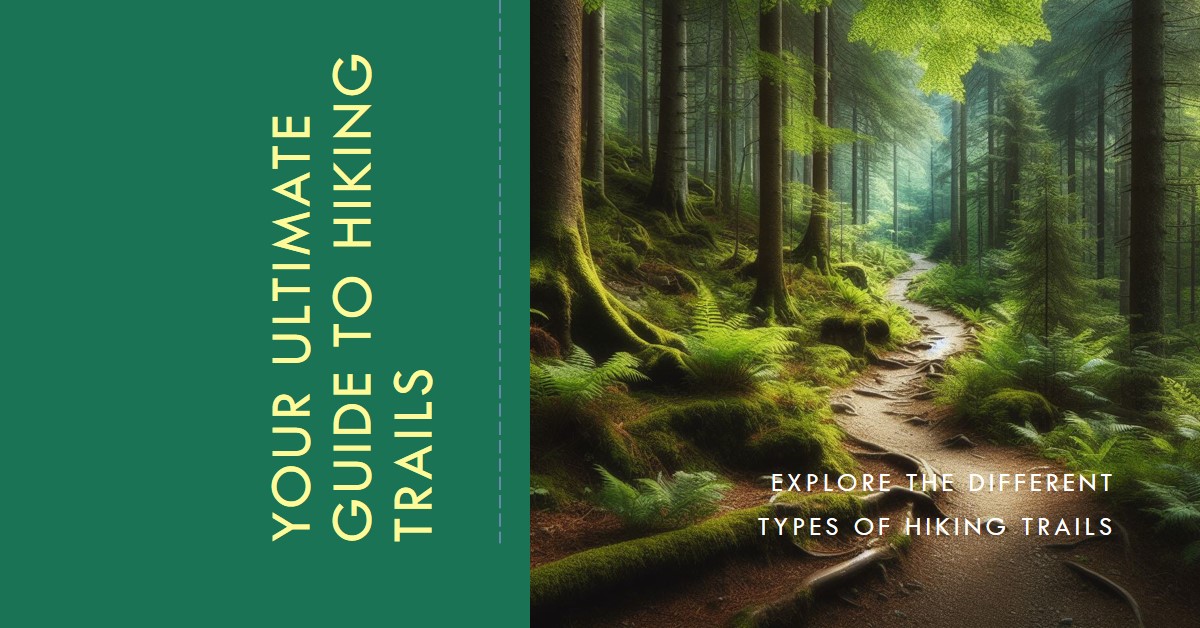The dawning realization you have as you prepare for a hiking trip is that suitable clothing is not negotiable – It’s essential. Layering your garments, from a thin moisture-wicking base to an insulating mid-layer, finished off with a waterproof outer shell like a raincoat can optimize comfort during your hike.
Swinging towards loose-fitting attires is recommended due to their allowance for airflow and their effectiveness in preventing excessive perspiration. Leggings, jogging bottoms, shorts, or skirts could be your go-to, depending on hiking conditions and the journey’s duration. Safety-conscious hikers often plump for bright colors like neon orange, yellow, and radiant red, however, subtle earth-tones appeal to those looking to create less of a visual disturbance.
When donning your hiking attire, critical factors to consider are location, weather conditions, and your hike’s planned duration.
Table of Contents
Selection Tips for Your Hiking Adventure Outfits
Stamping your influence in the great outdoors requires the right clothing attire – optimal comfort and protection ensured. Commence with a moisture-wicking base layer directly against your skin that moderates sweat and maintains dryness. Materials like merino wool or synthetic fabrics specifically engineered to draw moisture away from your body are greatly beneficial.
Add an insulating mid-line layer for added warmth during cold weather hikes. Fleece jackets or vests are coveted for this layer due to their excellent insulation properties combined with their lightweight and breathable nature. Finally, a waterproof outer shell, such as a rain jacket, is the perfect finish, making you water-resistant during damp weather conditions. Jackets with additional features like taped seams and adjustable hoods offer maximal protection against the elements.
Ultimately, comfort, moisture-wicking, insulation, and waterproofing should remain paramount when selecting your hiking attire. Securing appropriate gear gifts you the peace of mind and confidence to tackle any trail headfirst and maximize your outdoor adventures enjoyment.
Top Fabrics for Your Hiking Attire
| Top-Rated Fabrics for Hiking Attire |
|---|
|
In the quest to select top-grade fabrics for hiking clothes, synthetic materials, merino wool, and nylon usually stand supreme. Synthetic materials inclusive of polyester and nylon are renowned for being lightweight, durable, and fast-drying, hence very suitable for diverse weather conditions. They possess incredible moisture-wicking capabilities, maintaining your dryness and comfort throughout. Merino wool, an amazing natural fiber, is widely known and well-loved for its exceptional moisture-wicking and insulation competencies. It capably regulates body temperature, hence keeping you cool in hot weather and conversely warm during cold weather. Its natural odor-resistant feature makes it a favorite for longer hiking trips. Nylon, an equally great alternative, is revered for its abrasiveness resistance and durability. It offers excellent protection against thorny bushes, rocks, and other potential hazards you might encounter along the trail. These fabrics combined supply the requisite comfort, functionality, and performance pivotal for a successful hiking experience. |
Hiking Top Selection
Choosing the correct top for your hiking adventure is of utmost importance. Start off with a moisture-wicking base layer, include an insulating mid-layer for added warmth, and wrap it up with a waterproof outer layer like a rain jacket. These layers ensure your comfort and preparedness for any weather that you might encounter.
| Hiking Tops |
|---|
Selection of Hiking Shirts
|
Hiking Lower Garment Selection
When selecting the perfect lower garment for hiking, a couple of viable options arise: hiking pants, leggings, and shorts. Hiking pants are commonplace due to their protection against harsh vegetation and terrain, insects, sunlight, and accidental tumbles. For moderate or cold hiking weather, they supply sufficient insulation. Leggings are a fine choice for shorter and less strenuous hikes by providing comfort and a high degree of flexibility. Shorts are perfect for warmer weather hikes as they offer breathability and unrestricted movement. Skirts can also pass for shorter hikes during warmer spells. In essence, your bottom wear choice would hinge on the weather and the hike’s length and intensity.
Selection of Hiking Footwear
When picking the suitable footwear for hiking, keep comfort, support, durability in mind. Hiking boots provide ankle support and protection, particularly on unconventional terrains, hence a popular pick among many. Go for boots with optimum traction and a waterproof membrane to guarantee dry feet. Hiking shoes present a lighter and more flexible alternative to boots, perfect for less tricky trails. They offer a balance between comfort and durability. Hiking sandals are apt for hotter conditions and water crossings with their breathability and quick-drying features. However, they don’t bode well for rugged terrains or cold weather hikes. Irrespective of your footwear preference, ensure they are a perfect fit and provide necessary support and protection as you venture out.
Layering for Variable Weather
The act of layering is a pivotal hiking clothing tip, particularly for unpredictable weather conditions. In mild weather, opt for outfits that are both comfortable and breathable.
Embarking on thrilling hiking adventures? Clueless about what to wear? Fear not; we’ve got you covered with this detailed guide on “Hiking Outfits: Choose Your Adequate Armor”.
Choosing suitable clothing like moisture-wicking base layers and lightweight hiking pants could make a significant difference to your hiking experience. For sweltering weather, arm yourself with lightweight, loose clothes like shorts, skirts – anything that keeps you cool. If the cold winds are blowing, layer up with insulating mid-layers and a waterproof outer shell, such as a warm jacket and sturdy hiking pants to stay warm and shielded. Got a hike planned during the rainy season? Ensure you pack a waterproof rain jacket and matching slacks to stay dry. Keep in mind, the fabric of your clothing matters as much as the type of clothing item – opt for quick-drying materials. And yes, do think about using bug repellent to keep those pesky insects at bay during your hike!
More Than Just Clothes: Additional Considerations
Hiking goes beyond just donning the right attire. It is about being prepared for the journey, and part of that preparation is considering other factors like the breathability of rain jackets. Seek out rain jackets made from breathable materials that will both prevent moisture buildup and keep you comfortable during your hike.
Insect repellent clothing is also a worthwhile investment. Bugs can be pretty relentless, and using clothing treated with insect repellent takes care of this concern.
Do not overlook the importance of comfortable hiking socks. Choose ones crafted from moisture-wicking material to ensure dry, blister-free feet.
Last but not least, remember your sun protection accessories. A wide-brimmed hat and sunglasses are not just trendy accessories; they are crucial to shield your face and eyes from the sun’s harmful rays. Don’t forget to slather on some sunscreen on exposed skin for added protection.
Frequently Asked Questions on Hiking Attire: Clearing Your Doubts
Sometimes, even with all the information at the tip of our fingers, we tend to grope in the dark, primarily when it comes to making the right choices. This section comprises commonly asked queries about hiking attire, aiming to dispel your doubts and ensure that you are properly equipped for your hiking adventure.
Hiking In Style: What Should I Wear On A Hike?
When you prepare for a hike, focus on comfort and safety. We recommend a moisture-wicking base layer, insulating mid-layer, and a waterproof outer shell, like a rain jacket. Go for loose-fitting clothing to facilitate airflow and minimize excessive sweating. Choose brighter hues that enhance visibility and make you easily spot-able. Stay clear of cotton fabric and think about wearing leggings, shorts, or skirts instead of usual hiking pants.
Alternatives To Hiking Pants: What Else Can I Wear?
If hiking pants are not your thing, there are plenty of alternatives, such as leggings, joggers, shorts, or skirts that would do just fine. Please remember to take into account the weather and the intensity of your hike when choosing your bottom wear.
The Perfect Fit: Should Hiking Clothes Be Tight Or Loose?
When it comes to hiking clothing, loose is a sure win! Tight clothing may restrict airflow and induce excessive sweating. Wearing loose-fitting clothes fosters better breathability, ensuring optimal air circulation between your skin and clothes – a sure-shot way to stay relaxed during your summer hikes!
Shorts Vs. Pants: What Is Better To Wear While Hiking?
Picking between shorts or pants boils down to your comfort and the weather conditions. However, typically, pants offer better protection against harsh vegetation, uneven terrain, insects, strong sunlight, and unexpected falls. They also insulate better than shorts, thus making them an excellent choice for hiking in varied climatic conditions, right from moderate to cold.
Wrapping Up: A Look Back At Hiking Clothing Tips
Hiking is as much about the experience as it is about being prepared for it – and a significant part of that preparation is choosing the right attire. You can never go wrong with moisture-wicking base layers, insulating mid-layers, and waterproof outer shells to battle any weather conditions that come your way. Keep cotton at bay and select breathable materials that allow your skin to breathe.
Opt for loose-fitting clothing for a more effortless airflow, and remember that bright colors are your safest bet to ensure visibility on the trails. Hopefully, we have helped you gain a better understanding of what to wear on your exciting hiking exit – so the next time you plan, dress smartly and enjoy your adventure to the fullest!
Planning for a hiking adventure? Wondering what kind of clothes to wear for an exciting hike? Well, don’t fret! We’ve compiled everything you need to know in this comprehensive guide titled, “The Ultimate Guide to Hiking Clothes: What to Wear for a Safe and Comfortable Hike”.
One of your prime considerations should be the right clothing such as moisture-wicking base layers and lightweight hiking pants. The heatwave urging you to hike? Go lightweight, opt for loose clothing like shorts or skirts to maintain a cool body temperature. For those cold weather hikes, dress in layers with insulating mid-layers and a waterproof outer shell. A warm jacket with hiking pants can keep you cozy and well-guarded. And don’t let the rain showers dampen your hiking spirit! Always carry your waterproof rain jacket and pants for those rainy weather hikes. Make sure you choose clothing made from quick-drying materials and consider using bug repellent for a bite-free adventure.
The Extra Mile: Further Considerations
Hiking extends beyond wearing the right attire. The keys to a successful hike are also the comfort, functionality and protection that the right gear brings. A key factor to consider is the breathability of rain jackets. Always choose rain jackets made of breathable fabrics to prevent moisture build-up and keep you comfy on your hike.
Say goodbye to those annoying bugs with insect repellent clothing – clothing treated with insect repellents can keep those pesky bugs at bay.
Your feet carry the weight of the journey, so opt for socks made from moisture-wicking materials to keep your feet dry and blister-free.
Remember, the sun can be friend and foe. Protect your face and eyes from the harsh sun’s rays by wearing a wide-brimmed hat and sunglasses. Don’t forget to apply sunscreen to your exposed skin for that extra layer of sun protection.
Answering Your Queries: The FAQ Section of Hiking Clothes
Sometimes, information overload can still leave you in the dark, especially when the right choices seem elusive. This section caters to the most commonly-asked questions about hiking attire that clear up any vagueness and prepare you adequately for the journey ahead.
What Type of Clothes Should I Wear On a Hike?
Choosing your hiking attire isn’t just about style; it’s also about comfort, functionality and safety. We recommend a moisture-wicking base layer, an insulating mid-layer and a waterproof outer shell like a rain jacket. Opt for loose clothing to ensure proper airflow and to avoid excessive sweating. Go for vibrant colors to enhance visibility and to make sure you can be easily spotted. Ditch the cotton and instead consider leggings, shorts, or skirts alongside your hiking pants for ultimate comfort.
What Can I Wear Instead of Hiking Pants?
If hiking pants don’t float your boat, you have plenty of alternatives. Try leggings, joggers, shorts, or skirts as per your comfort and as dictated by the weather and the intensity of the hike.
Should Hiking Clothes Be Tight Or Loose?
Loose, definitely loose! Tight clothing can restrict your movement and cause excessive sweating. By opting for loose garments, you can promote better breathability and facilitate an excellent airflow between your clothes and skin, ensuring you stay comfortable all through your hikes, especially in the summer!
Shorts or Pants - What’s Best for Hiking?
While your comfort is primary, pants are generally a preferable choice when it comes to hiking because they offer superior protection against harmful vegetation, challenging terrains, bugs and falls. Not to mention, they provide better insulation compared to shorts, thereby making them a perfect fit for both moderate and cold hiking temperatures.
In Conclusion: Summarizing the Clothing Tips for Hiking
As you traverse the journey of hiking, choosing the right set of clothes can make a massive difference to your comfort and safety. Opt for moisture-wicking base layers, insulating mid-layers and waterproof outer shells to combat any weather scenario thrown at you. Say a big no to cotton and select breathable fabrics to let your skin breathe comfortably.
Wear garments that fit loosely to ensure better airflow and remember, bright colors always make you stand out enhancing visibility on the trials. So next time you’re prepping for a hike, ensure you’re dressing smart and savor the most out of your adventurous excursion!














